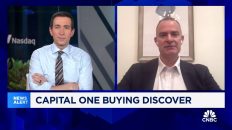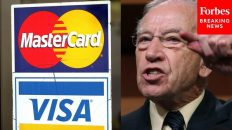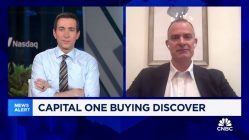“When you fix the gap, it’s not just that you’re spending some incremental dollars which you can say publicly that ‘we have no pay gap’ from either a gender or ethnicity perspective,” Schulman tells CNBC. “You can then attract the best talent to your organization and retaining those as well because now you know that’s something that we’re fully committed to.”
Julia Boorstin
CNBC
Published Thu, Mar 21 2019 • 11:40 AM EDT
PayPal CEO Dan Schulman on exactly how the company closed its pay gap
When Dan Schulman spun PayPal off from eBay four years ago, no one could tell the CEO whether the company was paying its employees fairly.
Schulman, who says PayPal’s mission is to democratize payments, thought it was crucial to have an equally inclusive approach to his employee base. In 2015, his team began working with outside consultants to identify and close the company’s pay gaps across gender and race.
For the first time Schulman is sharing how much that cost the company: $3 million.
Since then closing the gap has become a continuous process — and a major commitment for the company. This year the pay gap was about 90 percent less, which adds up to about $300,000. The company evaluates pay not just when it makes acquisitions, but three times a year, for all 20,000 employees.
“When you fix the gap, it’s not just that you’re spending some incremental dollars which you can say publicly that ‘we have no pay gap’ from either a gender or ethnicity perspective,” Schulman tells CNBC. “You can then attract the best talent to your organization and retaining those as well because now you know that’s something that we’re fully committed to.”
Schulman said when the consultants they hired identified the $3 million number, he faced some push-back from executives in HR and finance, who suggested it would make more sense to spread the cost out over a couple of quarters. But the CEO insisted on making the change immediately. “Truly in the great scheme of things,” he says, “it’s incredibly small.”
PayPal’s HR team worked with two outside consultancies to create a process to evaluate pay and performance to make sure the company is rewarding based on merit, without bias.
“It wasn’t going to be practical just to do this once,” says the company’s Chief Business Affairs Officer Louise Pentland, who has collaborated with Schulman on equal pay since she joined PayPal before the spin-off. “You have to do this multiple times, because equal pay isn’t a static moment, it’s a continuum.”
Here’s how it works: Managers establish a band of pay based on the type of role — there are 13 job categories across the company — and location. They examine the market for employees’ skills and their level of experience. How much employees are paid within that band depends on performance, which managers are asked to rate by answering a series of very detailed questions designed to eliminate bias.
The evaluation includes a dozen categories, including whether employees have met specific performance targets and applied skills such as strategy, vision, communication and collaboration. Managers rank employees performance across those categories on a scale ranging from “developing” to distinguished.”
“We don’t leave it to chance, and we don’t leave it to individual managers to pick their favorite people,” says Pentland. “You take away the…subjectivity.”
In the final phase, the HR team works with outside consultants to review pay and promotions across the company by gender and ethnicity and make adjustments. “It’s ensuring that you’ve got the guardrails in place,” she says. “You’ve got managers trained so that those unconscious bias behaviors don’t creep in, and then you’ve got third party assessment double checking, auditing almost those decisions that are made .”
One of the managers who’s been implementing this intensive pay process over the past four years is M.J. Austin, PayPal’s Senior Director of Technical Product Management. She’s a parent who returned to the workforce after taking time off with her young twins, since then she’s been promoted five times in 10 years. She was surprised to find that even she had unconscious biases.
“It doesn’t matter who you are and what your gender is,” says Austin. “That unconscious bias does show up. It shows up when you look at the salary that you’ve paid different employees and you say, ‘Wow why is this 2 percent less each year for say an employee who is female versus male?,’ and then you realize that going through this, there is just this natural unconscious bias that happens. ”
Austin says that performing the in-depth review process for each of her employees doesn’t actually generate any more work.
“It actually makes it a lot simpler, because it’s very clear what the objective framework says, and how to evaluate your employees,” she says. “From a management perspective, it’s like following step 1, 2, 3, and getting that done.” Austin says it’s helped her communication with her employees about their performance, and reduced the need for them to ask for promotions, when it’s on the table three times a year.
“We don’t leave it to chance, and we don’t leave it to individual managers to pick their favorite people.
Louise Pentland PAYPAL, CHIEF BUSINESS AFFAIRS OFFICER
That constant conversation about performance — and the promise of equal pay — is valuable for at every step of an employees’ career.
“Where it’s definitely given us an advantage is in recruiting talent,” says Schulman. “I think we have a really good reputation that we are looking for a diverse workforce, and when you have the best talent then you serve customers better than anybody else . And when we serve customers better, [we] serve shareholders better.”
But equal pay is just one challenge, and may actually be one of the easier ones to address, Schulman says.
The greater challenge is in bringing a more diverse group of employees into leadership. He transformed PayPal’s board from having just one woman to being 50 percent women and people of color. And he says 58 percent of the company’s employees are women and people of color (described by the company as “global females and ethnic males in the U.S.”), as are 51 percent of those employees who are VP-level or higher.
He’s also training employees at every level to address unconscious bias.
There’s no question that diversity makes the company better, says Schulman. “When you have a difference of opinion you make better decisions, because you can see all sides of the story,” he says. “When you don’t have that, you’re operating from one perspective alone and inevitably that’s going to be wrong.”
Schulman hopes other companies adopt PayPal’s philosophy. “It’s the right thing to do,” he says. “It’s also about self-interest as a company and how we best serve our customers, because this idea of more diverse companies perform better — that’s a fact.”











